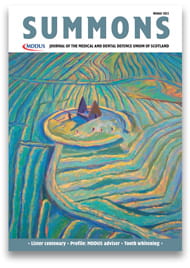BEFORE 1922 a diagnosis of diabetes mellitus meant certain death for many patients. That year a research team in Toronto managed to isolate a product of the pancreas key in the control of sugar metabolism and insulin* was first put into clinical use to treat diabetic patients. This team was led by a Scottish physician and physiologist named John James Rickard Macleod (JJR).
JJR was born in Perthshire, Scotland, the first son of Free Church minister Robert and his wife Mary. They moved to Aberdeen and he studied medicine at Aberdeen Marischal College. JJR graduated with Honourable Distinction in 1898 and went off to Leipzig to study physiological chemistry on a two-year scholarship. Restless, after only one year he returned to Aberdeen to study creatinine metabolism and then to London to demonstrate physiology at one hospital and to lecture in biochemistry and pathological chemistry at the Pathological Institute. He added a Diploma in Public Health to his accomplishments, published on a wide variety of subjects and at an unusually young age was appointed an external examiner in physiology at Aberdeen.
In 1903 he was appointed Professor of Physiology at the Western Reserve University in Cleveland, USA – he was only 27 and had just married his second cousin Mary McWalter. From 1906 he concentrated on carbohydrate metabolism. Claude Bernard (in France) had identified glycogen as the compound that stored sugar in the liver. Von Mering and Minowski had shown in 1898 that a dog whose pancreas had been removed would develop fatal diabetes. JJR confirmed this and thought it likely that a pancreatic secretion metabolised dextrose. Islet cells had been identified in 1869 by Langerhans. JJR reviewed the subject in a series of publications from 1907-1917 Studies in experimental glycosurea and in a monograph Diabetes: its pathological pathway in 1912. He was a good clinical observer of diabetes mellitus and an stablished expert in carbohydrate metabolism.
During WW1 JJR was asked to work on gas masks and food preservation. In 1918 he published Physiology and Biochemistry in Modern Medicine, the first edition of a classic. War prevented him from visiting Scotland and perhaps he had not felt comfortable as an expatriate in the USA so he welcomed a move to Toronto as Professor of Physiology.
In 1921 a young researcher named Frederick Banting came to JJR with a request for laboratory space to attempt to isolate a compound in the pancreas that was thought to control sugar metabolism. Experimenting first with dogs Banting was helped by medical student Charles Best. Others joined the team, including biochemist James B Collip.
JJR used his experience and encyclopaedic knowledge to guide the young team to rigorous proof of the existence and function of insulin. By the spring of 1922 a limited supply of purified insulin from ox and calf pancreas was in clinical use. JJR arranged for insulin to be patented in Collip and Best's names. Eli Lilly was the commercial distributor in the USA. For the UK the Toronto authorities offered rights to the Medical Research Council.
The achievement earned Banting and Macleod the 1923 Nobel Prize for Medicine and Physiology but by then relations within the team had soured amid arguments over who deserved credit for the discovery. Banting shared his prize money with Best while Macleod shared his with Collip. Over time the acrimony in Toronto with Banting and his supporters became unbearable to the publicly reticent character of JJR, so he was delighted when he could step into the shoes of his teacher in the Regius Chair of Physiology at Aberdeen. He was also made honorary consultant physiologist to the Rowett Research Institute and the Torrey Fishery Station where he did more useful research on metabolism.
JJR was an eloquent and clear speaker and writer and received numerous invitations and honours: elected FRS Canada in 1918, London 1923 and Edinburgh 1932. He gave the Harvey Lecture in New York in 1914 and was President of the American Physiological Society for 1922-23. He gave his Nobel lecture in Stockholm in 1925 - The Physiology of Insulin and its Source in the Animal Body. Ill health in 1934 prevented him from giving the Croonian Lecture at the Royal Society. He died in Scotland the following year.
* The name insulin was chosen by JJR although he later apologised to Sharpey- Shafer in Edinburgh who had actually coined it earlier.
Source: J. J. R. Macleod: The Co-discoverer of Insulin Michael J Williams. Proceedings of the Royal College of Physicians of Edinburgh July 1993 Vol 23 No 3 Supplement No. 1
Julia Merrick is a freelance writer and editor in Edinburgh
This page was correct at the time of publication. Any guidance is intended as general guidance for members only. If you are a member and need specific advice relating to your own circumstances, please contact one of our advisers.
Read more from this issue of Insight

Save this article
Save this article to a list of favourite articles which members can access in their account.
Save to library